Osaka city guide: How to spend a weekend in Japan's second city
What to do if you’ve got 48 hours in this up-and-coming tourist hub
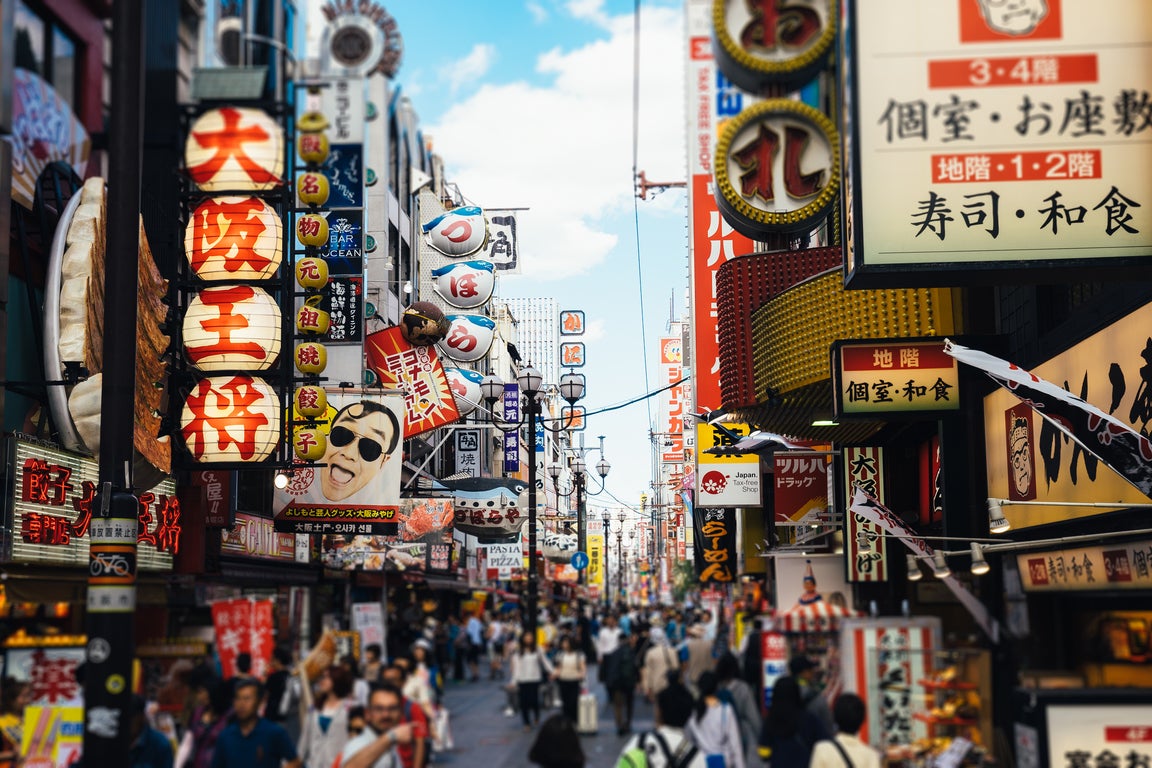
Your support helps us to tell the story
From reproductive rights to climate change to Big Tech, The Independent is on the ground when the story is developing. Whether it's investigating the financials of Elon Musk's pro-Trump PAC or producing our latest documentary, 'The A Word', which shines a light on the American women fighting for reproductive rights, we know how important it is to parse out the facts from the messaging.
At such a critical moment in US history, we need reporters on the ground. Your donation allows us to keep sending journalists to speak to both sides of the story.
The Independent is trusted by Americans across the entire political spectrum. And unlike many other quality news outlets, we choose not to lock Americans out of our reporting and analysis with paywalls. We believe quality journalism should be available to everyone, paid for by those who can afford it.
Your support makes all the difference.Why go now?
The long-suffering transit hub for former imperial capital Kyoto (1), Japan’s second city Osaka is finally having its moment in the spotlight as more than just a fun night out (although what a fun night out it is). In 2016, 9.4 million tourists landed in Osaka, up 31 per cent on the previous year, according to the city’s tourism authorities.
The recent opening of Festival Tower West (2) (festival-city.jp/english), the second tower of Japan’s highest twin towers development, in Osaka’s Nakanoshima district has lent the sandbank sandwiched between the city’s business districts a buzzy feel. And its newest hotel opening, the Conrad Osaka (3) (conradhotels3.hilton.com), which crowns the top floors of the West Tower, has done nothing to dent its cool appeal.
Autumn is Osaka’s loveliest season: the heat disappears, the leaves turn a rich brown and there are far fewer tourists around than in the ever-popular cherry blossom season in spring.
Get your bearings
Osaka feels far more compact than its megalopolis big sister, Tokyo – even though 19 million people live in its wider area.
The city is easy to navigate on the efficient metro system (although the subway stations themselves are more like airports), and most of the sights you’ll want to see fan out from the central JR Osaka Station (4) (osakastation.com), so it’s easy to see things on foot.
Day one
Take a view
You’ll arrive from Kansai Airport (5) into the sprawling central JR Osaka Station (4). On the 14th floor of the North Tower of JR Station City (6) (osakastationcity.com/en) is a hidden urban farm filled with cucumbers, tomatoes and blueberries; walk up from the 11th floor. It offers blockbuster views over western Osaka – spot the robot-like Umeda Sky Building – as well as being a great spot to catch the sunset.
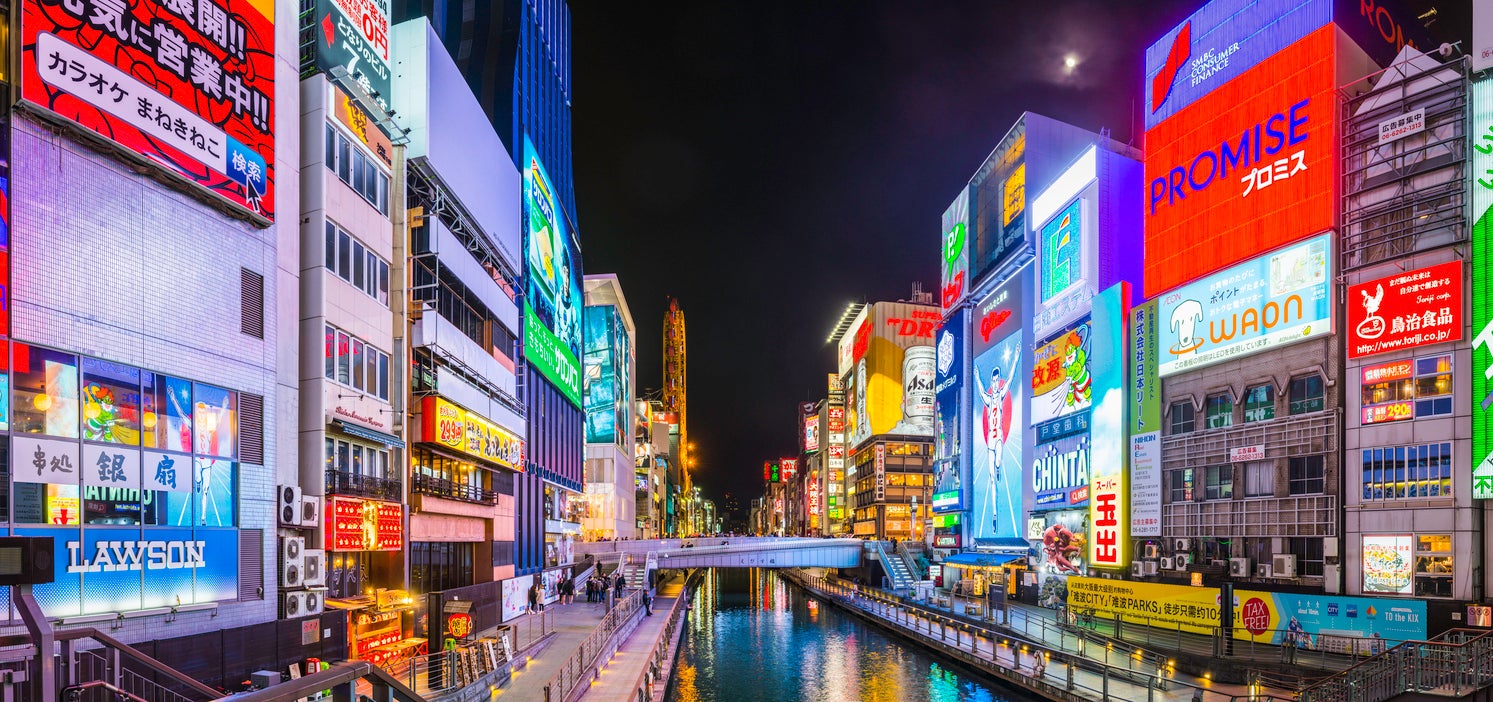
Take a hike
During the Edo period in Japan (1601-1867), Osaka was known as “the nation’s kitchen”. That heritage is borne out at the covered Kuromon Market (7), a series of arcades selling fresher-than-fresh sushi and sashimi, T-shirts and trinkets, plus some bizarre homewares. There are also plenty of casual restaurants to grab a bowl of ramen or a beer.
Around the corner is Nipponbashi, the home of Osaka’s wacky cosplay culture. On Ota Road (8) you’ll find seven-storey department stores dedicated to anime, selling magazines, cards, movies and more, as well as maid cafes, where everything is served to you by gussied-up cosplayers with pigtails.
Lunch on the run
Down one of the many backstreets around busy Namba Station is equally busy Nosta Ramen (9) (nosta.jp), a square wooden bench surrounding a central kitchen. The signature dish is ramen, topped with tender pork slices and mountains of beansprouts. Come hungry: you can buy noodles – done the traditional way, al dente – by weight from the vending machine. Open daily 11am-3pm and 6-9pm.
Cultural afternoon
With the 2018 Osaka opening of the Kosetsu Museum of Art in Festival Tower West (2), which will house a traditional, thatched-roof Japanese tearoom, Nakanoshima is cementing its reputation as quite the art hub.
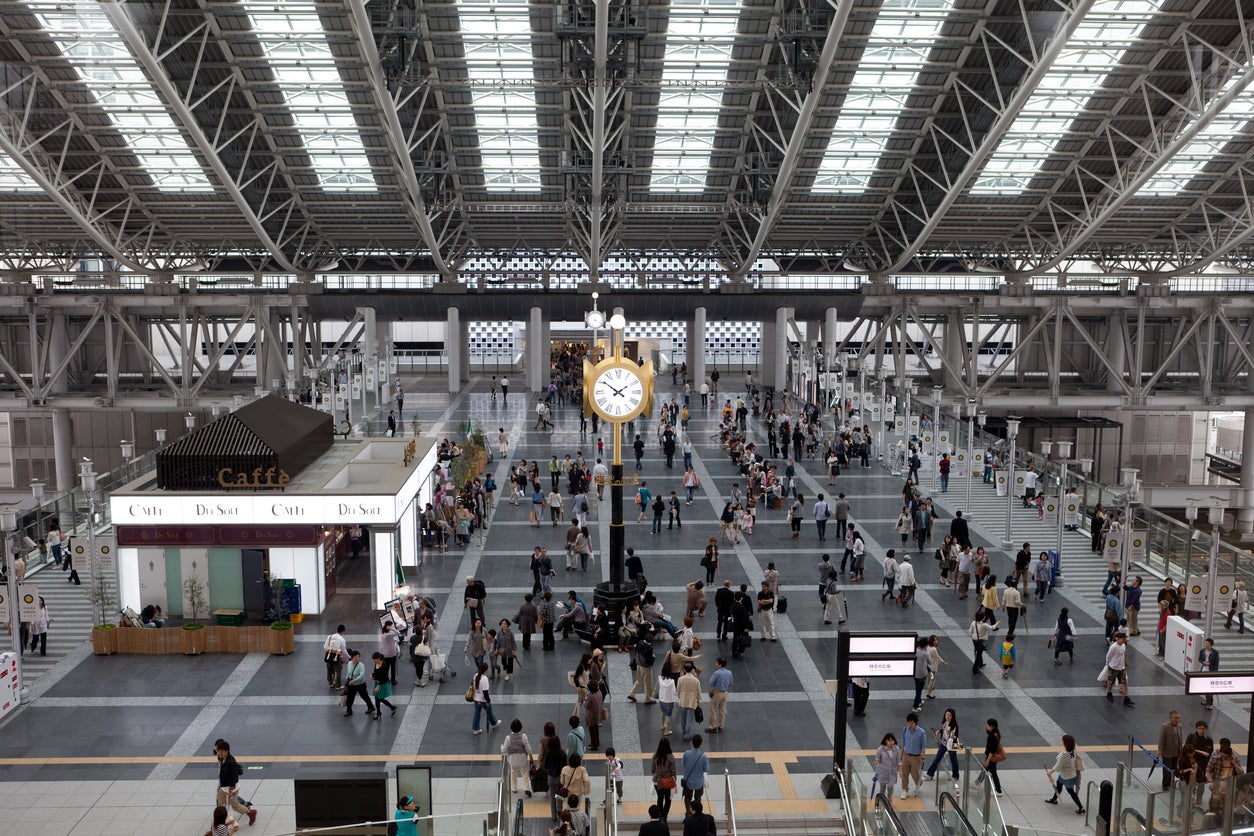
Nearby Festival Tower East (which also has a vast theatre in the basement, with regular performances from travelling orchestras and ballets) boasts the subterranean National Museum of Art (10) (nmao.go.jp/en). There are rotating exhibitions, and it’s just acquired some contemporary Japanese art pieces. Look for the twisty steel entrance and head down. Open Monday to Friday 10am-5pm, 10am-9pm at weekends; 430 yen (£2.88) entry.
An aperitif
The Conrad’s 40 Sky Bar & Lounge (3) (conradhotels3.hilton.com) is the city’s hottest sundowner spot – and the Takoyaki in the Sky cocktail its most Osakan wheeze. A takoyaki ball, a local speciality in the form of an octopus meatball, comes perched on top of a gin and blue curacao drink.
Dine with the locals
Neon-lit Dotombori (11) is zingy at any time of day, but when the sun goes down it really gets going; and its boiled-sweet-coloured signs look particularly Instagrammable. Street vendors open up, prodding takoyaki balls and flipping okonomiyaki, a type of Osakan pancake, usually with pork or prawns. With so many stalls, the best advice is to look for the biggest queue and join it.

For more formal dinner plans, try any of the wooden-fronted restaurants by the Hozen-ji Temple (12). You’ll recognise them by the gauzy fabric hanging from their doors.
Day two
Out to brunch
For proper eggs, try Hawaiian imported chain Eggs & Things (13) (eggsnthingsjapan.com/shinsaibashi). There’s a branch in Shinsaibashi serving eggs done in every way and some Hawaiian specialities. Open 9am-10pm daily.
Window shopping
Japan’s long trade relationship with America is the reason behind the bizarre, playful Amerikamura (14) district in Shinsaibashi. Streets lined with stamp-sized vintage fashion and jewellery shops push up against over-lit, overstimulated Pachinko halls, and all of them pump out early 2000s hip-hop. It’s a haven for vinyl record collectors – swing by Root Down Records (15) (rootdownrecords.jp/for-foreigner) or Vinyl Chamber (16) (vinylchamber.com), open 12-8pm. Make sure you visit the mini Times Square (17), complete with mini Statue of Liberty, to complete the bizarre tour of this place.
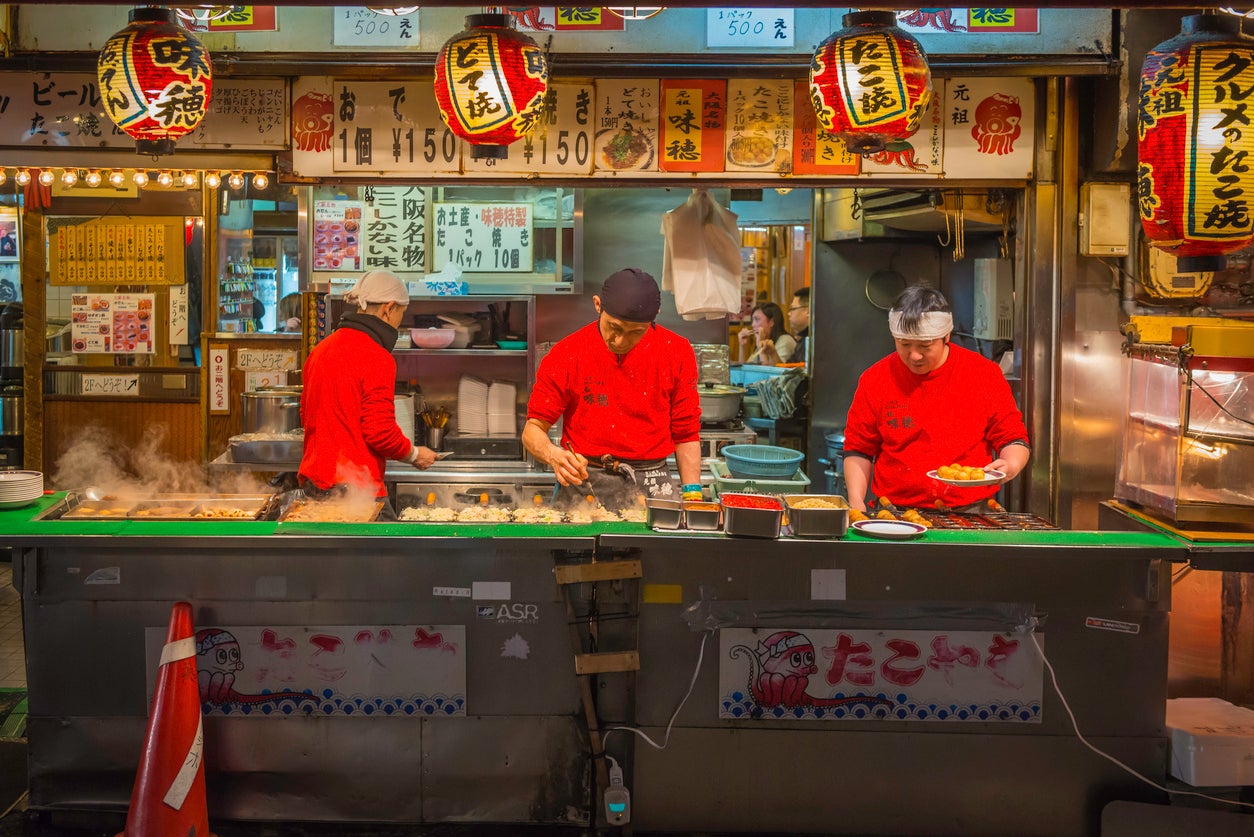
Walk in the park
Osaka Castle (18) (osakacastle.net/english) dates back to 1583 and crowns an elegant, 106-hectare park complex with a plum garden, a Grove of Remembrance and – weirdly – a tree stump that commemorates where a monk once took off his habit. There are trees of all kinds in the park, including cherry (that flower in spring). Open 9am-5pm daily; entry 600 yen (£4).
Take a ride
If you’ve come all this way, you’re probably going to want to see temple-studded Kyoto too. It’s only 30 minutes away from Osaka Station, and an easy day out: walk the steps flanked by thousands of orange tori gates of Fushimi Inari-taisha (19) and cycle around the bamboo groves of Arashiyama (20).
Then book for dinner at Sushi Wakon (21) (sushiwakon.com), helmed by a Michelin-starred chef in Kyoto’s traditional core, Gion. With only 10 seats at a table carved out of a single piece of cherry wood, the restaurant does an excellent omakase menu, selected daily depending on what’s freshest at Tokyo’s Tsujuki Fish Market. Open 11.30am-1.30pm and 5.30-10.30pm daily.
The icing on the cake
Osaka’s main draw is that it’s an easy city to have fun in, and nowhere more so than in its micro bars around Ura Namba. The Misono Building (22) has an underground atmosphere, with many small bars that stay open very, very late on the first floor.
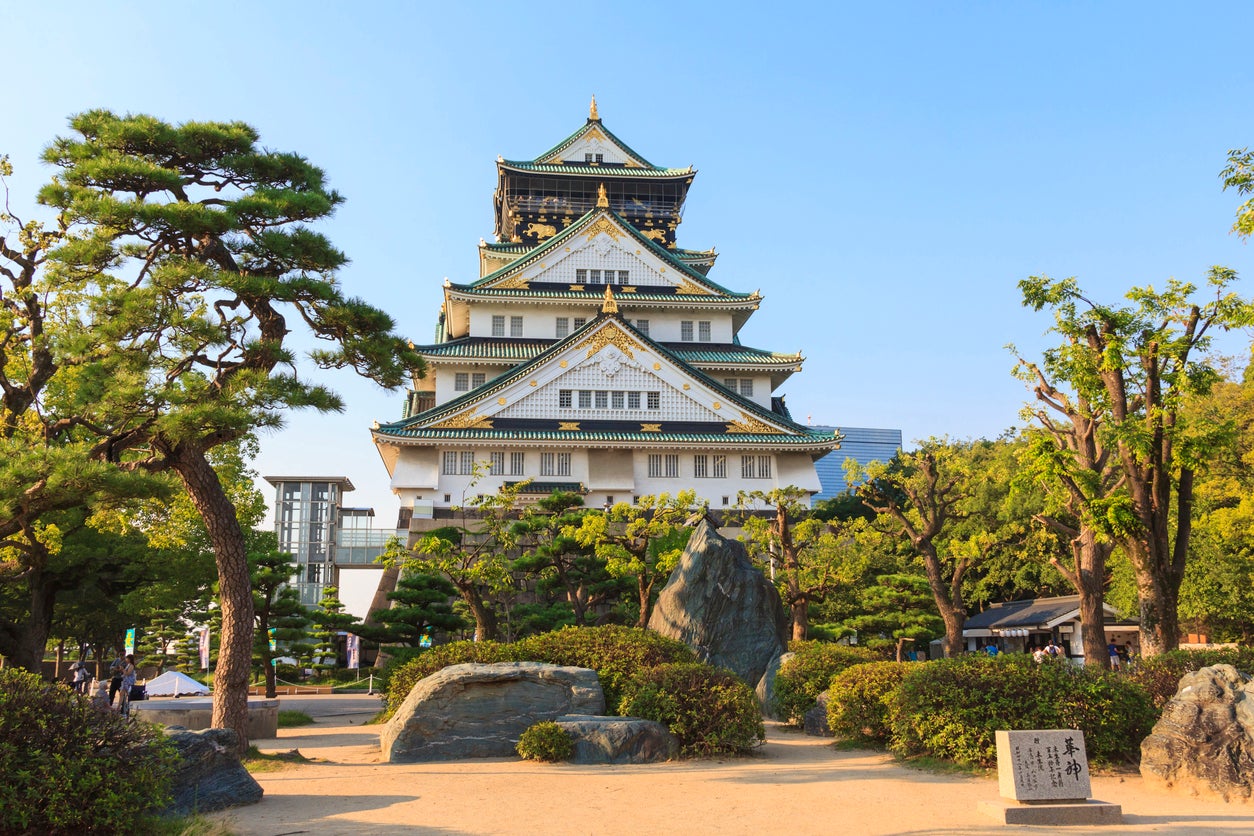
Travel essentials
Getting there
There are no direct flights between the UK and Kansai. Many European, Middle Eastern and Asian carriers fly to Kansai from London with a stop. Return fares start from around £420 return.
Trains run between Kansai Airport and Osaka. Tickets cost from 1,200 yen (£8) for a single, or alternatively buy a pay-as-you-go travelcard that can be used on the train systems in Osaka and Kyoto. Trains either run a local, rapid or express service and are priced accordingly – check before you get on.
Staying there
Newest opening Conrad Osaka (3) (0081 662 220 111; conradhotels3.hilton.com) has all the accoutrements of a stylish luxury bolthole – vast, glassy rooms with killer views, top-class restaurants and an Instagram-worthy swimming pool. Doubles from 45,000 yen (£300), B&B.
Landing early or late into Kansai Airport? Recently opened First Cabin (23) (0081 072 456 5526; first-cabin.jp) offers cosy, compact capsules for the night with neatly organised amenities. The premium cabins come with more space, meaning you can stand up in them. Capsules from 6,200 yen (£41), room only.
Accommodation bookshop Book & Bed Kyoto (24) (bookandbedtokyo.com/en/kyoto) is a quirky choice for a night in the old imperial capital. Doubles from 4,300 (£29), room only.
More information
Join our commenting forum
Join thought-provoking conversations, follow other Independent readers and see their replies
Comments